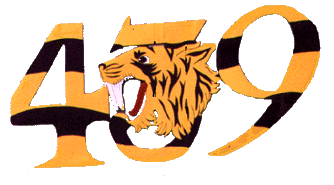|
History
of
 Squadron Squadron
  
Chapter
VII
The Advance to the Rhine
February
- March 1945
|
Brunen, another flak stronghold which had been causing considerable trouble to the troop carriers coming in on the Wesel dropping zones, was the target for eight cluster bombs dropped by Bill Davis's section. No flak was in evidence after the attack, nor could the pilots find any guns in action as they
"stooged about" over the landing area. A pall of smoke hung over the countryside. On the last two "cab ranks" led by W/C Grant and F/L Le Gear the visibility was so poor that no ground movements could be seen, nor could the pilots distinguish any results of their attacks on gun concentrations and vehicles. Instead of dodging flak the pilots had to avoid supplies being dropped to the paratroops on the ground!
The day's final operation, a twelve plane effort with 1000 lb. bombs was a fiasco as group control was unable to bring them over the Smoke obscured target, the enemy headquarters and communication centre at
Dingden, before fuel shortage forced the pilots to jettison their bombs and turn homeward. The 24th had been a perfect day with not a cloud in the sky and only the haze and smoke to interfere with the air campaign.
|
Intentionally
left blank
|
Intentionally
left blank
|
The next five days, however, were less favourable, with overcast skies which prevented
operations on the 27th and 29th. On the other days the squadron continued its cluster bombing of enemy gun positions in support of the Army which was now consolidating its bridgehead across the Rhine. Gun concentrations at Anholt, north of Rees, were attacked twice with good effect, on the morning of the 25th by formations of eleven and eight aircraft. Many direct hits were seen on the guns and one
cluster fell on the command post. No movement could be seen on the ground and the guns were silent when the Typhoons reformed and set
course for base.
These artillery squelching expeditions were followed by three section attacks upon more guns near Isselburg and
Anholt that had been shelling the bridges thrown across the Rhine. F/L Davis's quartet silenced four artillery posts with their fragmentation bombs; F/L Le Gear's section hit three more guns with cannon fire, and F/O Marlatt saw four clusters fall on the third target. The day ended with another raid on Dingden which had better results than the previous effort against this target. From the ruins of Wesel the formation of twelve turned north along the railway towards the objective. The reflection of the setting sun on the banks of mist and smoke caused some trouble in pinpointing, but
the cluster bombs were well concentrated in the town, throwing up columns of smoke from every quarter.
|
|
One particularly large explosion was seen in the centre of the town, and on the northern outskirts a large building was ablaze. The pilots commented that
"considerable light flak on a road south of the town added colour to the proceedings." The whole wing took part in a "cab rank" affair on the 26th to squelch artillery positions in the woods
south east of Haldern. After the Army marked the target with red smoke a rocket squadron went in, followed by No. 440 and No. 439 with cluster bombs. Low rain clouds forced the pilots to start their steep dives at 5000 feet and light flak gave them a warm reception until two sections turned to thoroughly strafe the woods; then the fire ceased.
Breaking into sections, the pilots reconnoitred for ground targets and were rewarded with some vehicles and locomotives. One staff car was claimed as destroyed. Another car and an armoured vehicle were damaged on the next
operation during which enemy troops were bombed and clusters of MET were strafed. Then the whole squadron bombed
Erle, north east of Wesel, where a German battalion headquarters was located. Flak, stirred up by a Spitfire squadron just before the Tiffies arrived, was very intense but scored no hits.
  
Copyright
©1998-2016 Michael T. Melnick. All rights reserved
the
unofficial homepage of  Tiger
Squadron Tiger
Squadron
.
.
|
|